Motor units
1/120
There's no tags or description
Looks like no tags are added yet.
Name | Mastery | Learn | Test | Matching | Spaced |
|---|
No study sessions yet.
121 Terms
What are the two main sources of descending input to the spinal cord in motor control?
The motor cortex and brainstem centers
What is the function of the motor cortex in the descending motor system?
Planning, initiating, and directing voluntary movements
The brainstem centers are primarily involved in what type of movement control?
Basic movements and postural control
The cerebellum coordinates ongoing movement by integrating __________ and __________ input.
sensory
motor
The basal ganglia are involved in ________ proper initiation of movement.
gating
What type of neuron acts as the final common pathway to skeletal muscle?
Lower motor neurons (in the motor neuron pools)
What is the role of local circuit neurons in the spinal cord?
Integrate lower motor neuron activity using sensory input and descending signals
What two components modulate movement indirectly by influencing upper motor neurons?
The cerebellum and basal ganglia
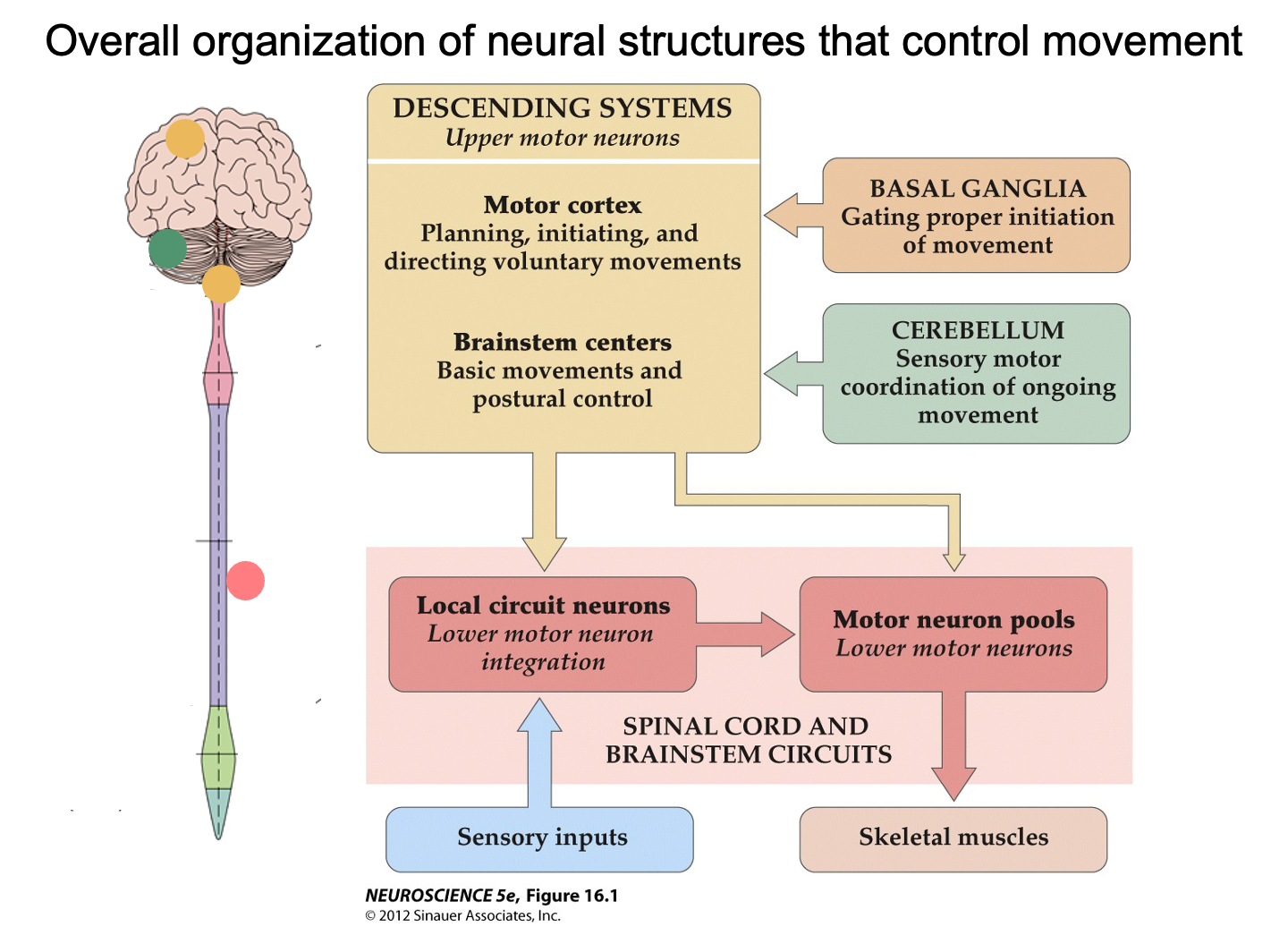
What is the direction of signal flow from the brain to skeletal muscle?
Motor cortex/brainstem → spinal cord (local circuit & lower motor neurons) → skeletal muscles

What defines a motor unit?
A single α-motor neuron and all the muscle fibers it innervates
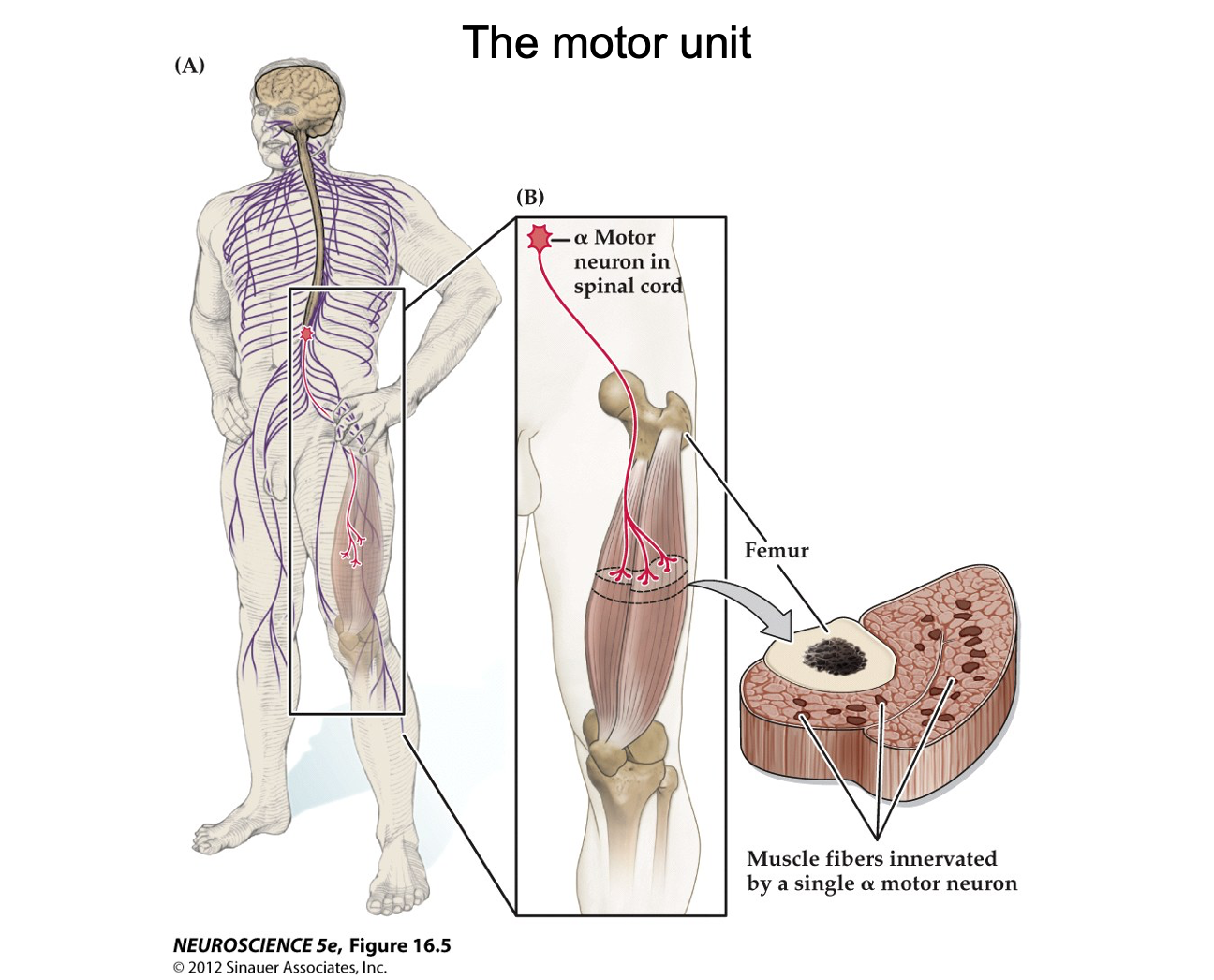
A motor neuron can innervate __________ muscle cells, which all contract together when the neuron fires.
multiple
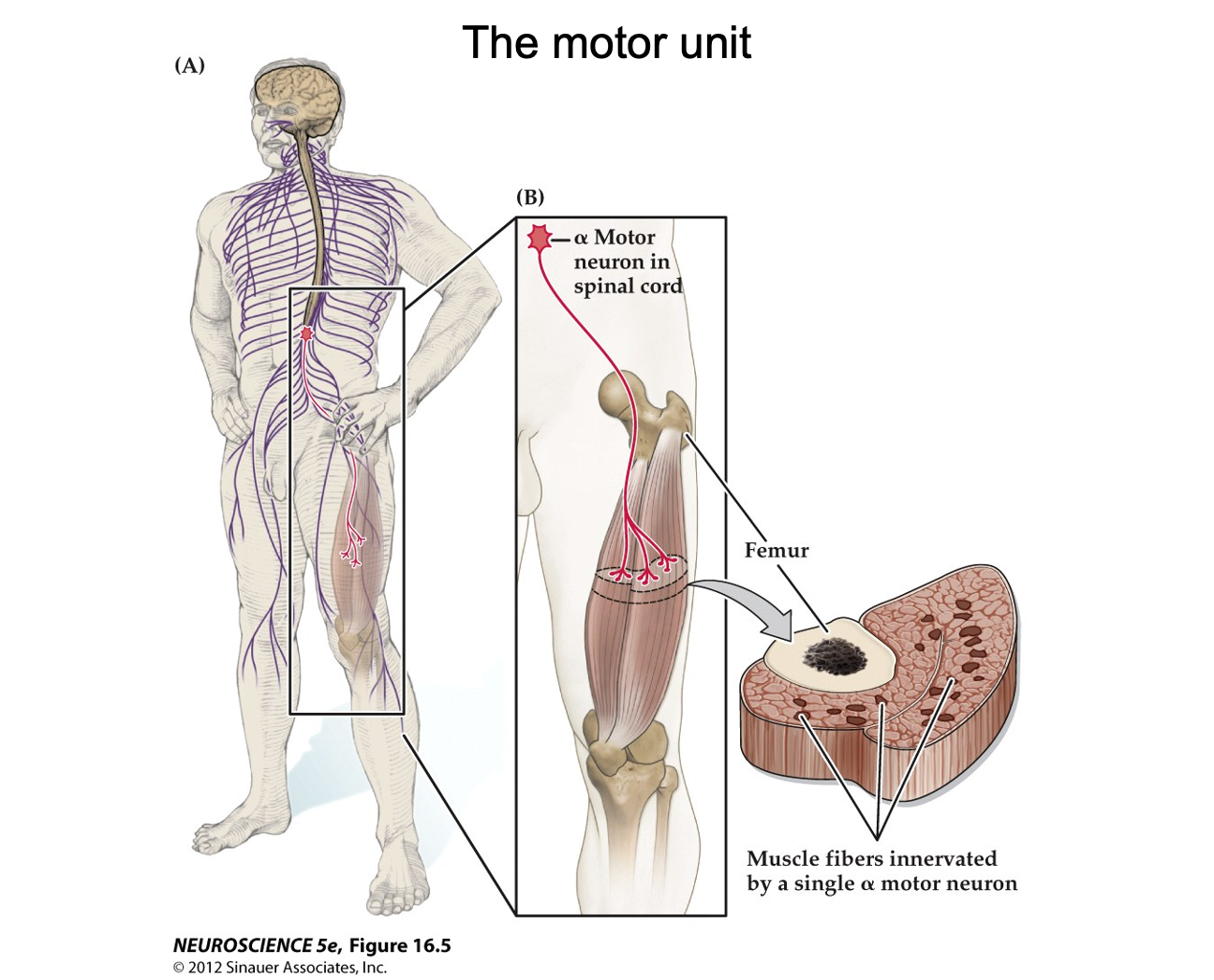
Why do all the muscle fibers in a motor unit contract simultaneously?
They are all innervated by the same α-motor neuron
Are the muscle fibers of a motor unit clustered or dispersed within the muscle?
Scattered throughout
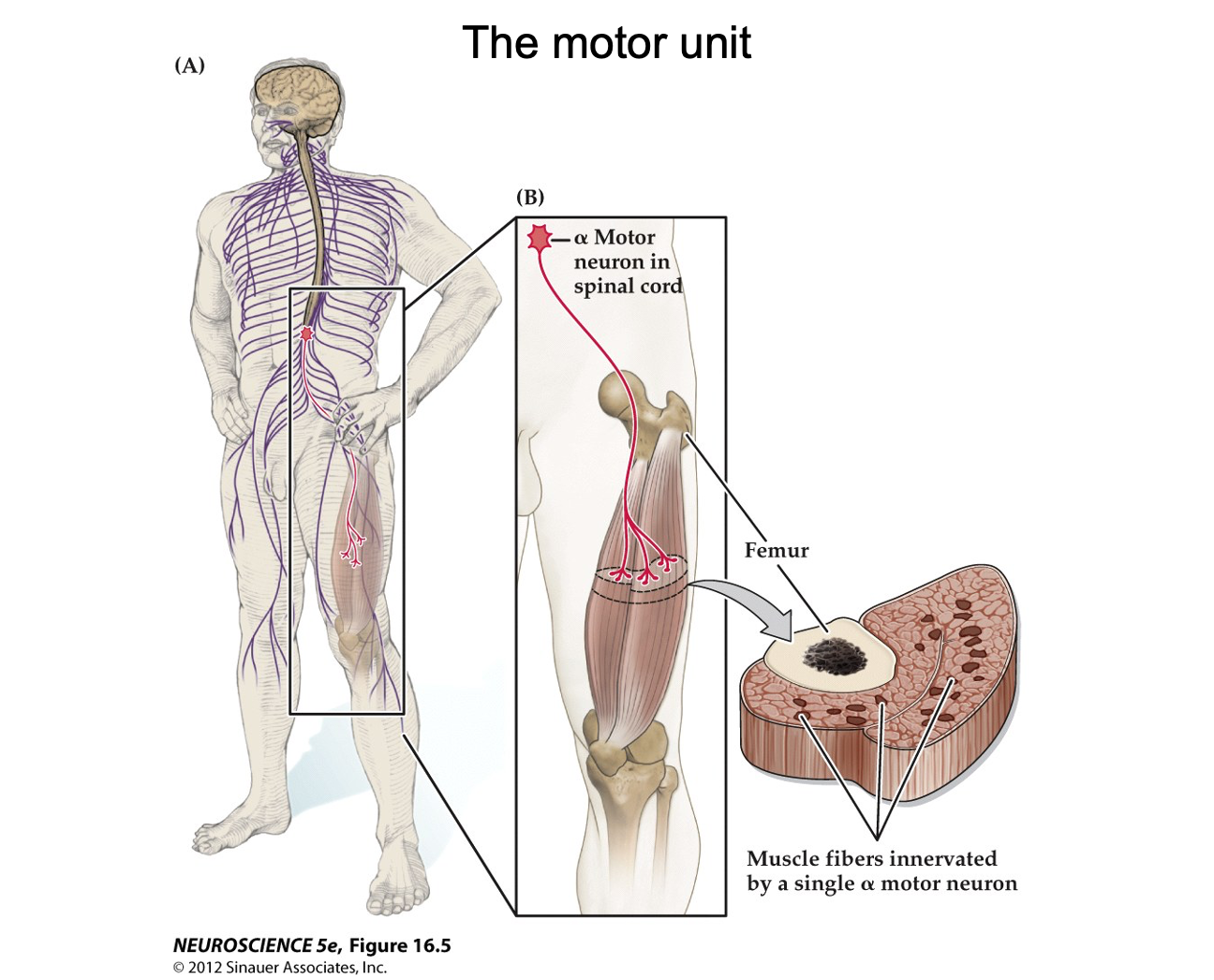
What is the path of an α-motor neuron from the spinal cord to the muscle fibers?
The neuron exits the spinal cord, travels down the peripheral nerve, and branches to innervate scattered muscle fibers in a single muscle
What is a motor neuron pool?
A group of motor neurons in the spinal cord that innervate a single muscle

Motor neurons that innervate a given muscle are located in the __________ horn of the spinal cord.
ventral
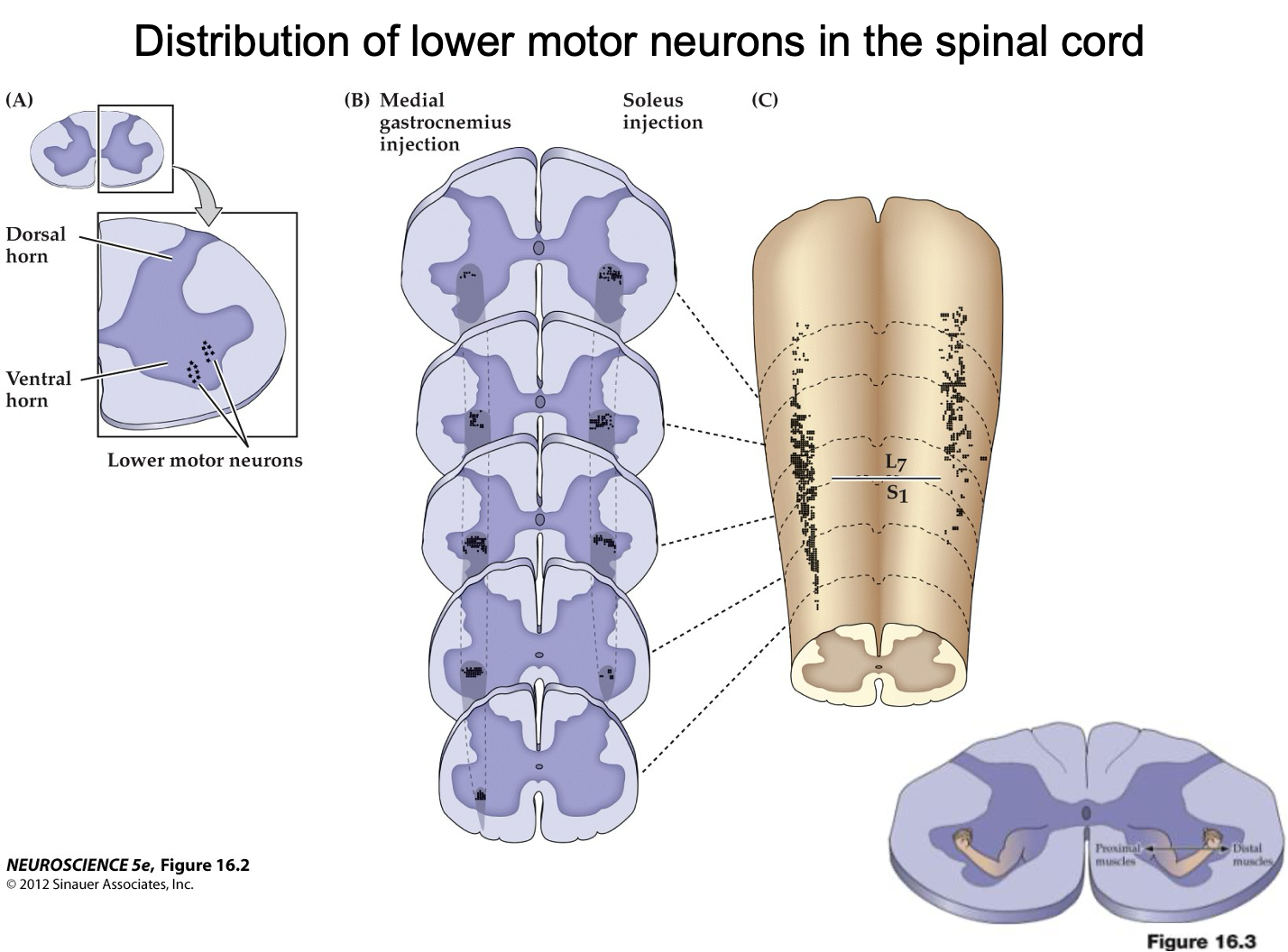
Are all the motor neurons for a muscle found in one spinal segment?
No — motor neuron pools often span several spinal segments
Where in the ventral horn are motor neurons for distal muscles (e.g., fingers) located?
The lateral portion
Motor neurons for proximal muscles (e.g., trunk) are located more __________ in the ventral horn.
medially
True or False: One motor neuron controls an entire muscle.
False — many motor neurons form a pool to control different fibers in the muscle.
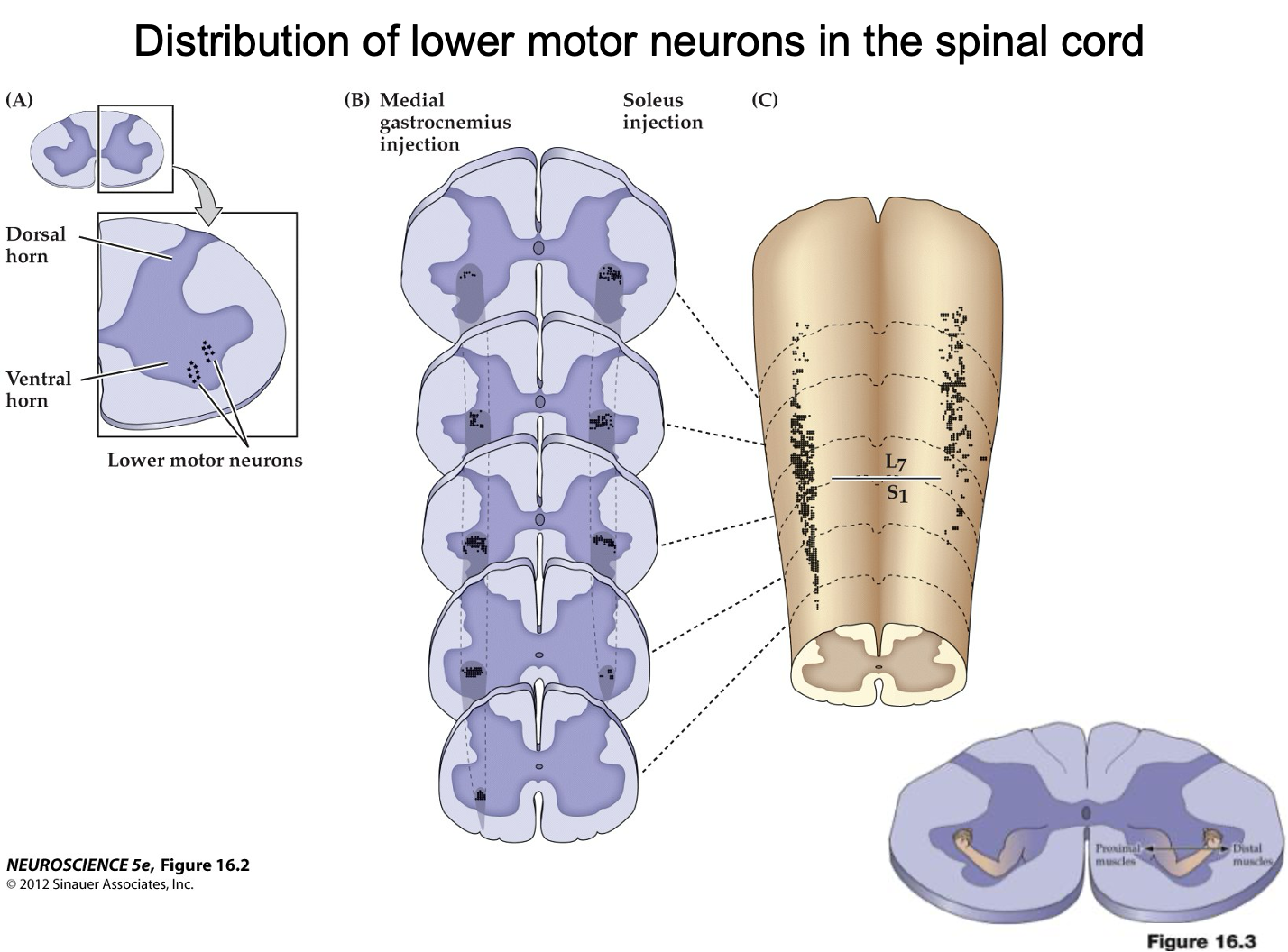
What is the significance of motor neuron pool distribution in spinal cord injuries?
Different injuries may selectively affect certain pools, impacting specific muscles based on segmental and medial-lateral organization
What type of neuron is the largest in the spinal cord and CNS and directly controls skeletal muscle?
The α-motor neuron
Projection neurons have __________ axons that extend to distant CNS regions, while interneurons have __________ axons that act locally.
long
short
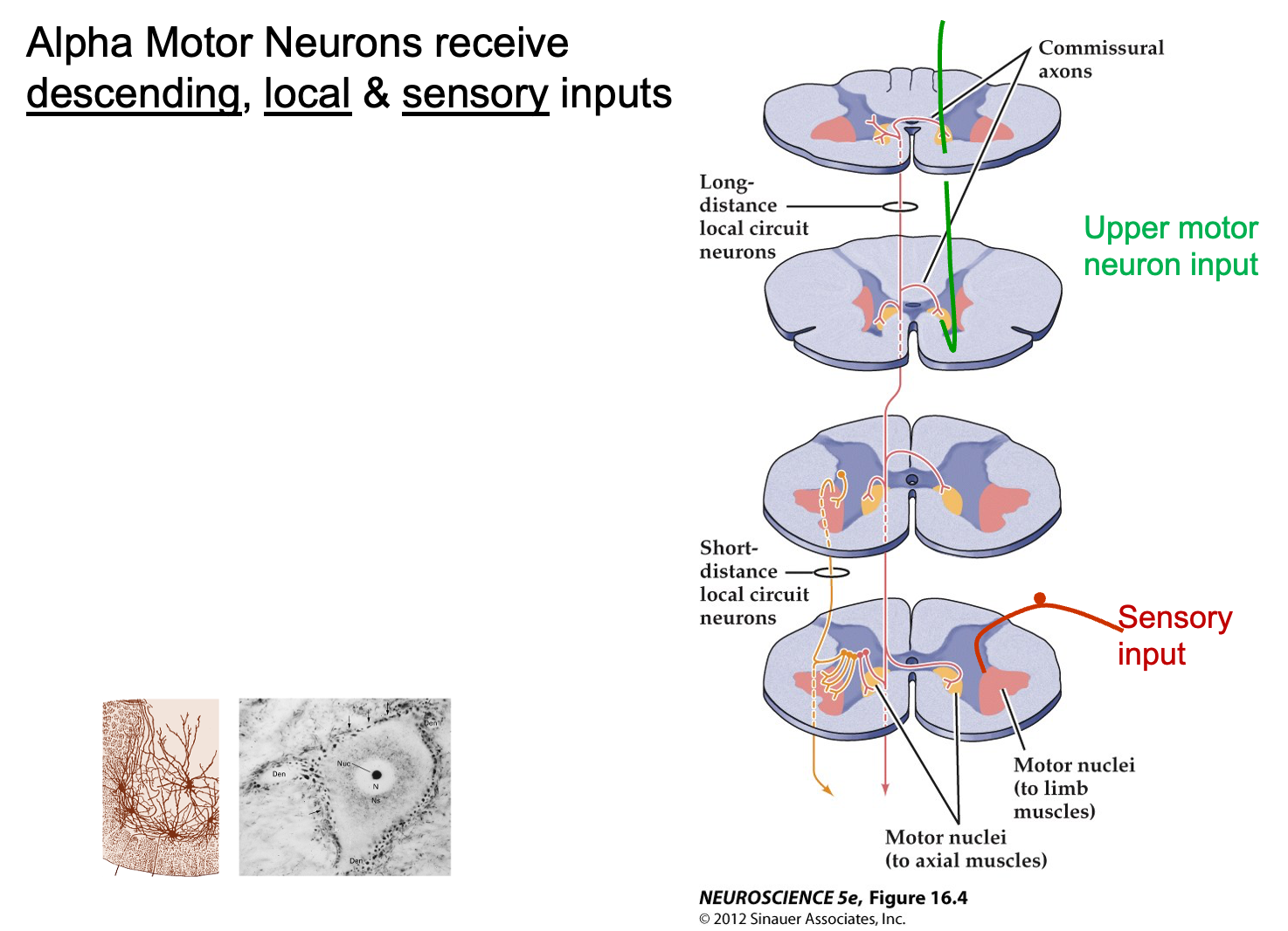
Interneurons that innervate medial regions of the ventral horn terminate ________ and coordinate _______ segments.
bilaterally
multiple
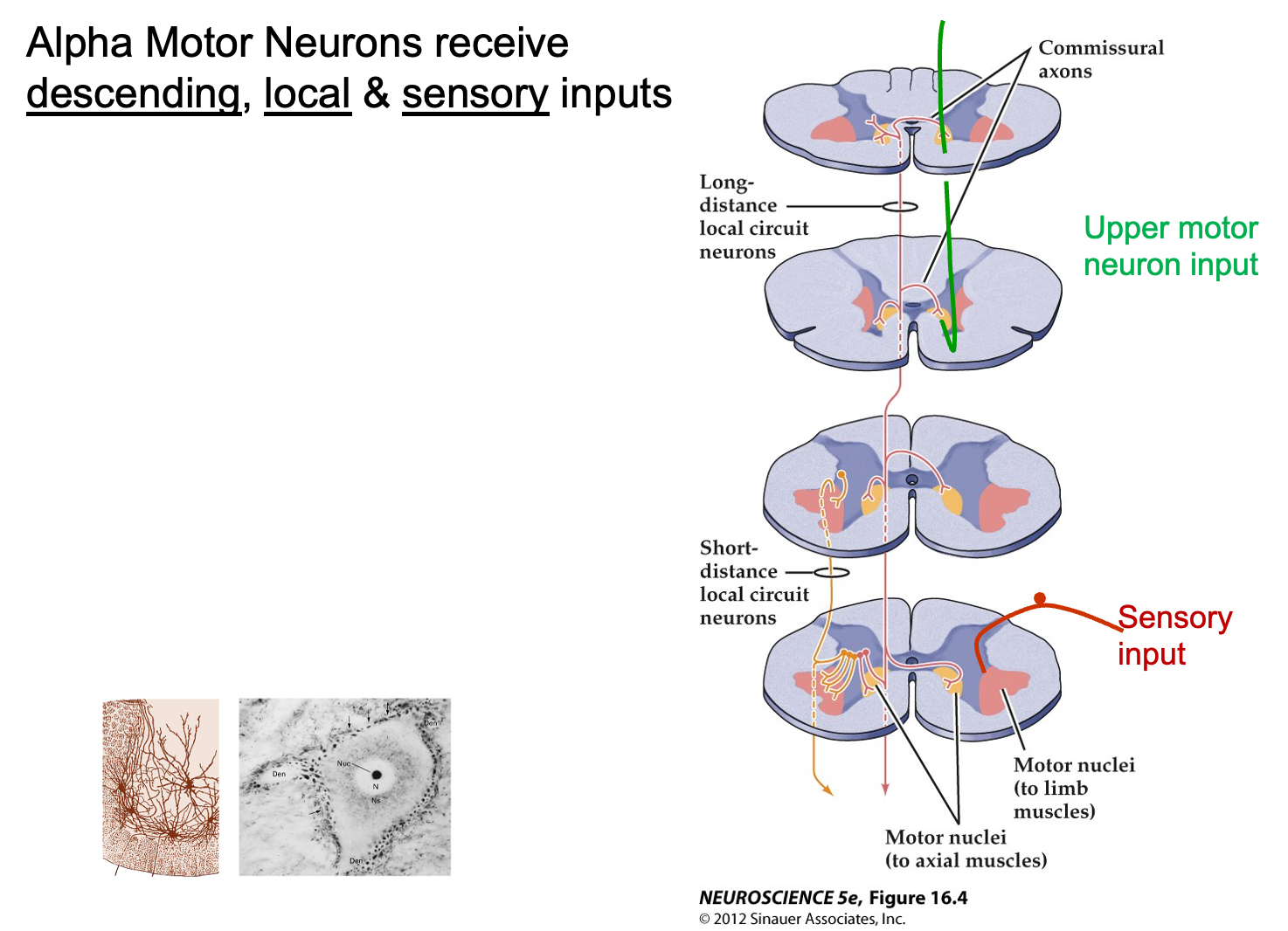
Interneurons that innervate lateral regions of the ventral horn serve _______ segments ________.
single/few
unilaterally
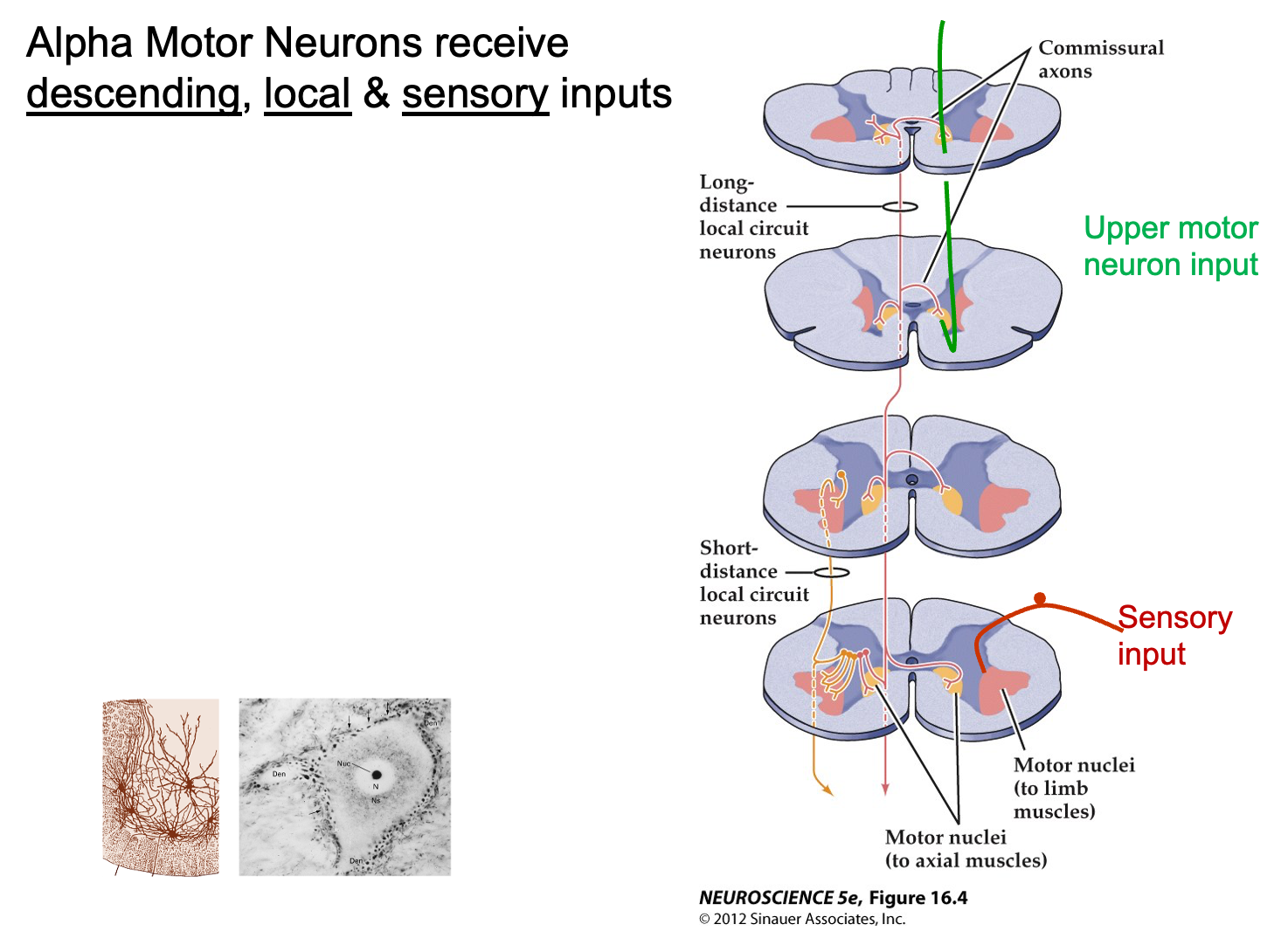
Where do long-distance local circuit neurons typically terminate, and what is their function?
Bilaterally across multiple segments to coordinate axial (trunk) muscle control
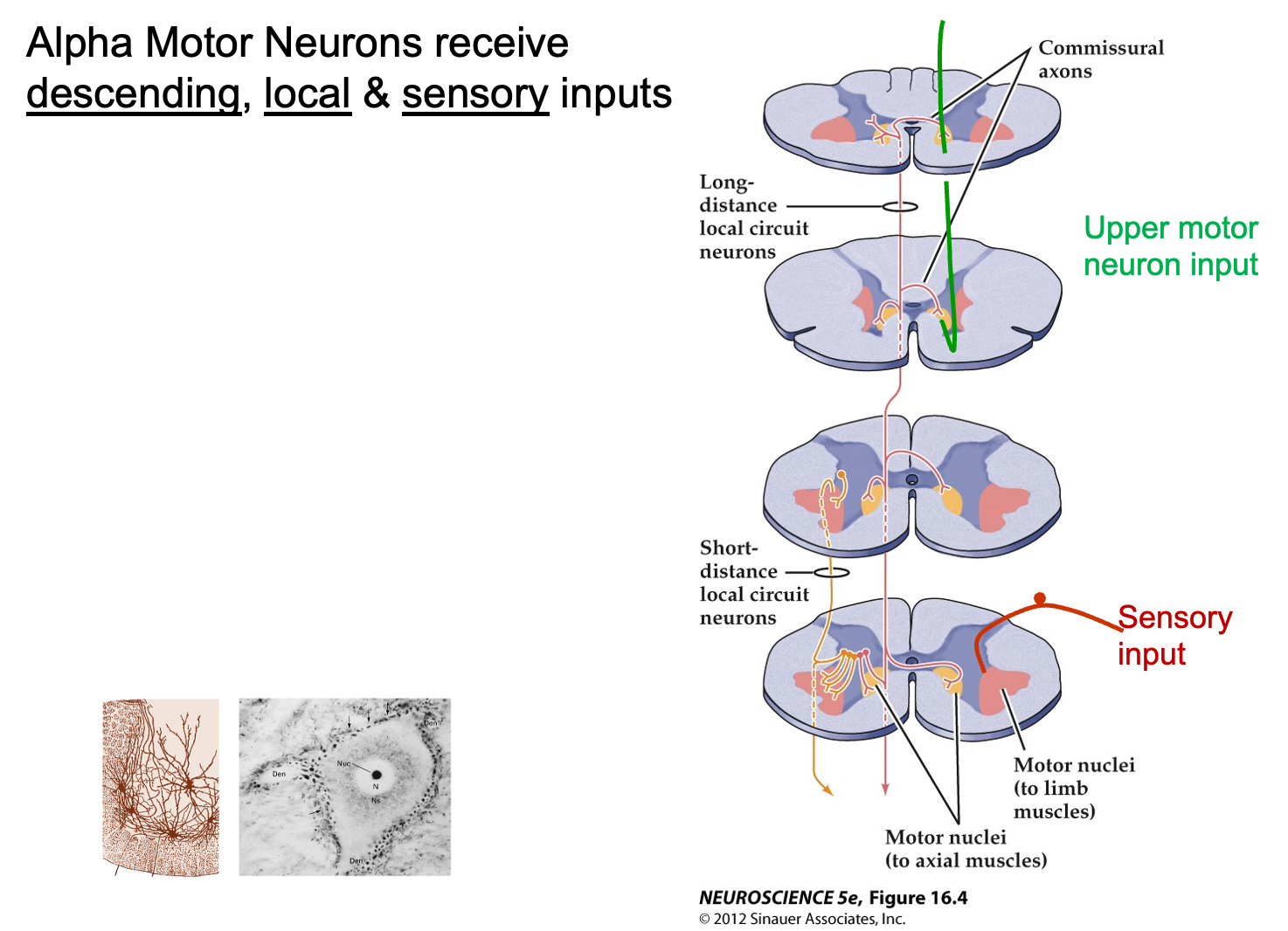
What is the role of short-distance local circuit neurons?
They operate unilaterally over a few spinal segments to coordinate distal limb muscle movement
How do sensory inputs influence motor activity in the spinal cord?
They synapse on local circuit neurons and α-motor neurons to modulate reflexes and movement
Which neurons in the spinal cord receive both sensory input and upper motor neuron input?
α-motor neurons and local circuit interneurons
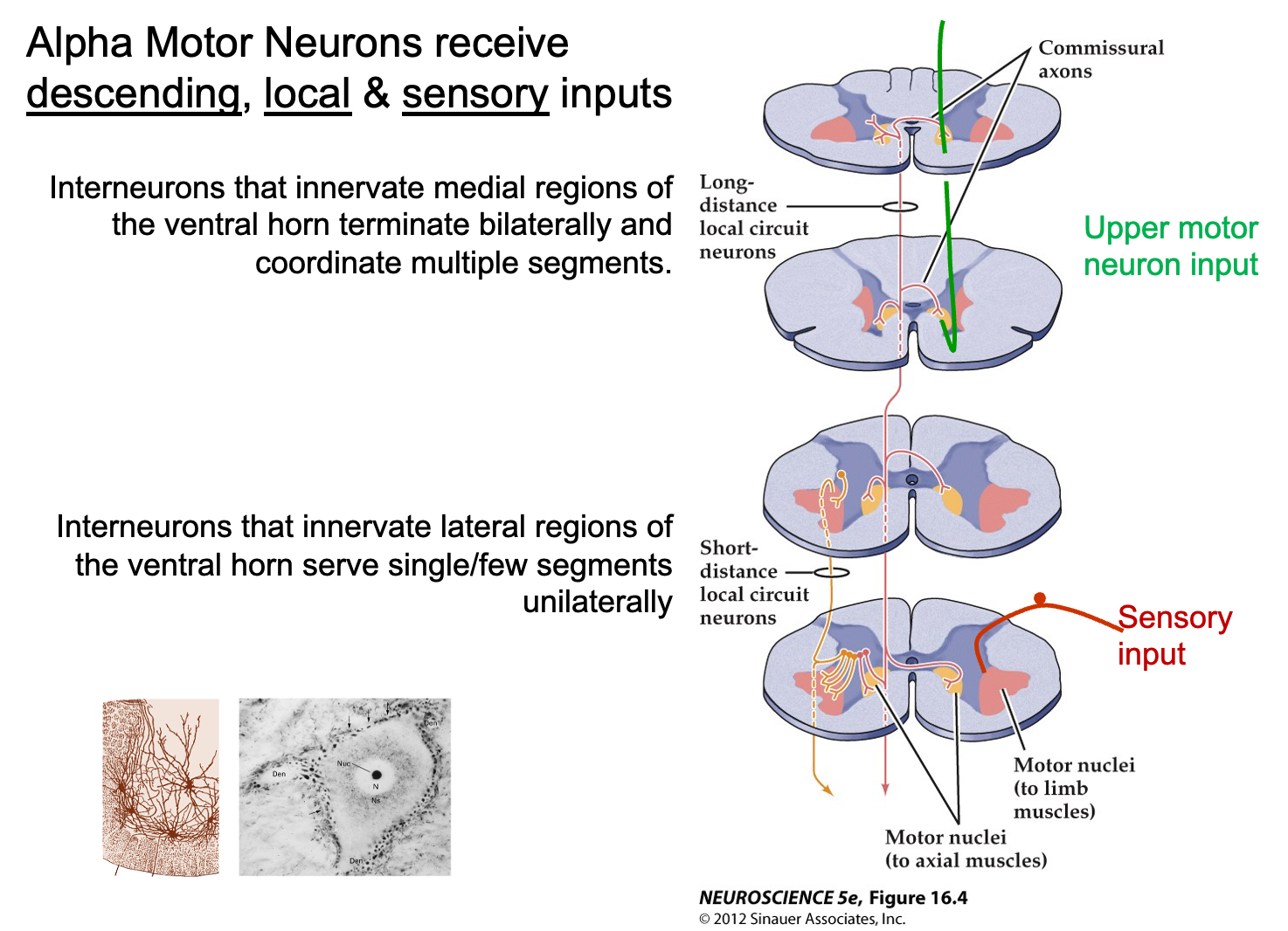
In the diagram, how do upper motor neuron inputs and sensory inputs contribute to motor control?
Upper motor neurons descend and modulate spinal circuits; sensory neurons provide real-time feedback to refine movement
What are the three major types of muscle fibers?
Type I (slow oxidative)
Type IIA (fast oxidative; intermediate)
Type IIB (fast glycolytic)
Slow / Type I motor units:
Red muscle fibers
Low myosin ATPase activity
Large number of mitochondria and enzymes
Slow to contract, slow to fatigue: sustain contraction
Low force production
Fast / Type IIB motor units:
White muscle fibers
Highest myosin ATPase activity
Few mitochondria, anaerobic (glycolytic) metabolism
Contract rapidly; fatigue rapidly
Large force production
Type IIA muscle fibers contract faster than Type I fibers but are more fatigue-_________ than Type IIB fibers.
resistant
How are motor units classified based on the muscle fibers they innervate?
Slow, intermediate (fast oxidative), and fast (fast glycolytic) motor units — matching the fiber types
What is a defining feature of all muscle fibers within a single motor unit?
They are all the same metabolic fiber type (e.g., all Type I or all Type IIB)
Why do all muscle fibers in a motor unit contract together?
Because they are all innervated by the same α-motor neuron
The motor neuron coordinates activity in its motor unit, leading to __________ contraction of all its fibers.
synchronous
What is a myofiber?
A single muscle fiber or muscle cell that contracts when stimulated by a motor neuron

The myofibers of each motor unit are ______ in the muscle
All myofibers of one unit are of the _____ fiber-type
dispersed
same
Which motor unit type produces the highest force but fatigues the fastest?
Type IIB (fast fatiguable) motor units
Which motor unit type produces intermediate force and is fatigue-resistant?
Type IIA (fast fatigue-resistant) motor units
Which motor unit type produces the least force but can contract for the longest time?
Type I (slow) motor units
Which motor unit type would a sprinter rely on most?
Type IIB (fast fatiguable)
Which motor unit type is predominant in postural muscles?
Type I (slow)
Three different types of motor units deliver ______ levels of force
different
What type of muscle fiber is most abundant in endurance athletes like marathon runners?
Type I (slow-twitch) fibers
What does a high percentage of Type I fibers allow an athlete to do?
Sustain low-force contractions over long durations without fatigue
The ratio of Fast Twitch and Slow Twitch fibers _____ from muscle-to-muscle and across individuals
varies
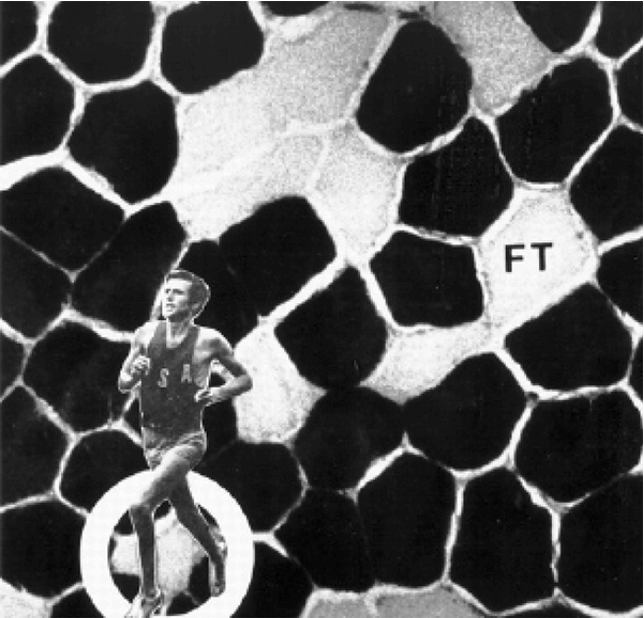
Gastrocnemius muscle from a world-class marathon runner, Frank Shorter (Olympic gold, 1972; silver, 1976)
In the histological image, dark fibers represent __________ muscle fibers.
slow-twitch (Type I)
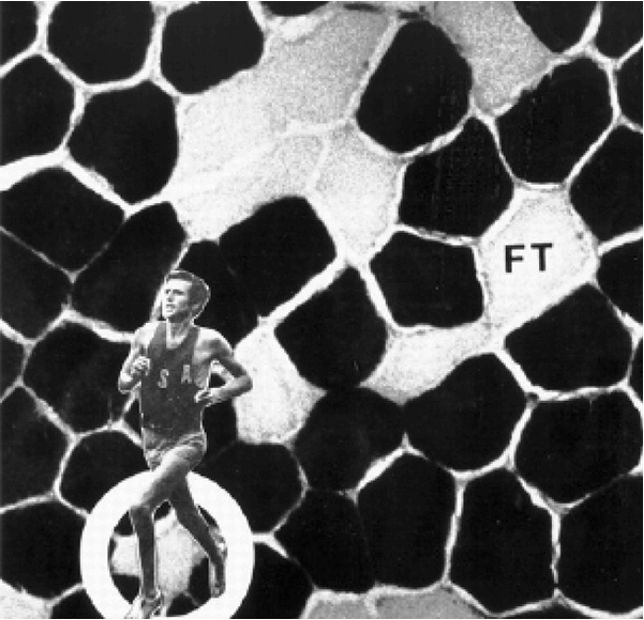
What muscle trait shown here supports the idea that some athletes are "naturally gifted" for endurance sports?
A genetically higher proportion of slow-twitch (Type I) fibers
The ratio of Fast Twitch and Slow Twitch fibers varies from muscle-to-muscle and across individuals
Muscles were compared from
untrained subjects
good long-distance runners
elite distance runners
Significant differences quantified in:
Muscle enzyme activities
Cross-sectional areas of individual muscle fibers
Area occupied by slow vs fast fibers
What is the innervation number (or ratio) in a motor unit?
The number of myofibers innervated by a single α-motor neuron
What does a low innervation ratio indicate about a muscle’s function?
It is specialized for fine, precise control (e.g., extraocular muscles).
What kind of movement is the medial gastrocnemius adapted for based on its motor unit size?
Powerful, gross movement — it has a high innervation ratio
Muscles with large motor units generate more __________ but have less precise control.
force
Motor units vary in size: smaller α-motor neurons innervate _____ muscle fibers.
fewer
A single α-motor neuron may innervate:
as few as 3 muscle fibers (extraocular muscles)
as many as 1800 fibers (medial gastrocnemius)
this is termed the “innervation number” or “innervation ratio”
Large muscles can have nearly ____ units (biceps brachialis); small muscles may have ____ units (abductor digiti minimi).
1000
≤ 50
A given muscle can have ________ units
both large and small
Why is innervation ratio clinically relevant in neurology?
It helps evaluate motor control deficits and patterns of denervation or reinnervation
Graded Control of Muscle Tension by Alpha-Motor Neurons:
The twitch of a single skeletal myofiber looks ________.
But entire muscles can produce _____ levels of tension.
all-or-none
variable
Graded Control of Muscle Tension by Alpha-Motor Neurons
This ability for graded contractions is regulated by:
Varying the firing rate of motor neurons
Recruiting additional motor units (also recruiting synergist muscles)
Muscle force increases when the firing rate of a motor neuron is __________.
increased
What type of motor unit is recruited first during gradual increases in force?
Small, slow (Type I) motor units — according to the Size Principle
What type of motor unit is recruited last, only when maximum force is needed?
Large, fast (Type IIB)
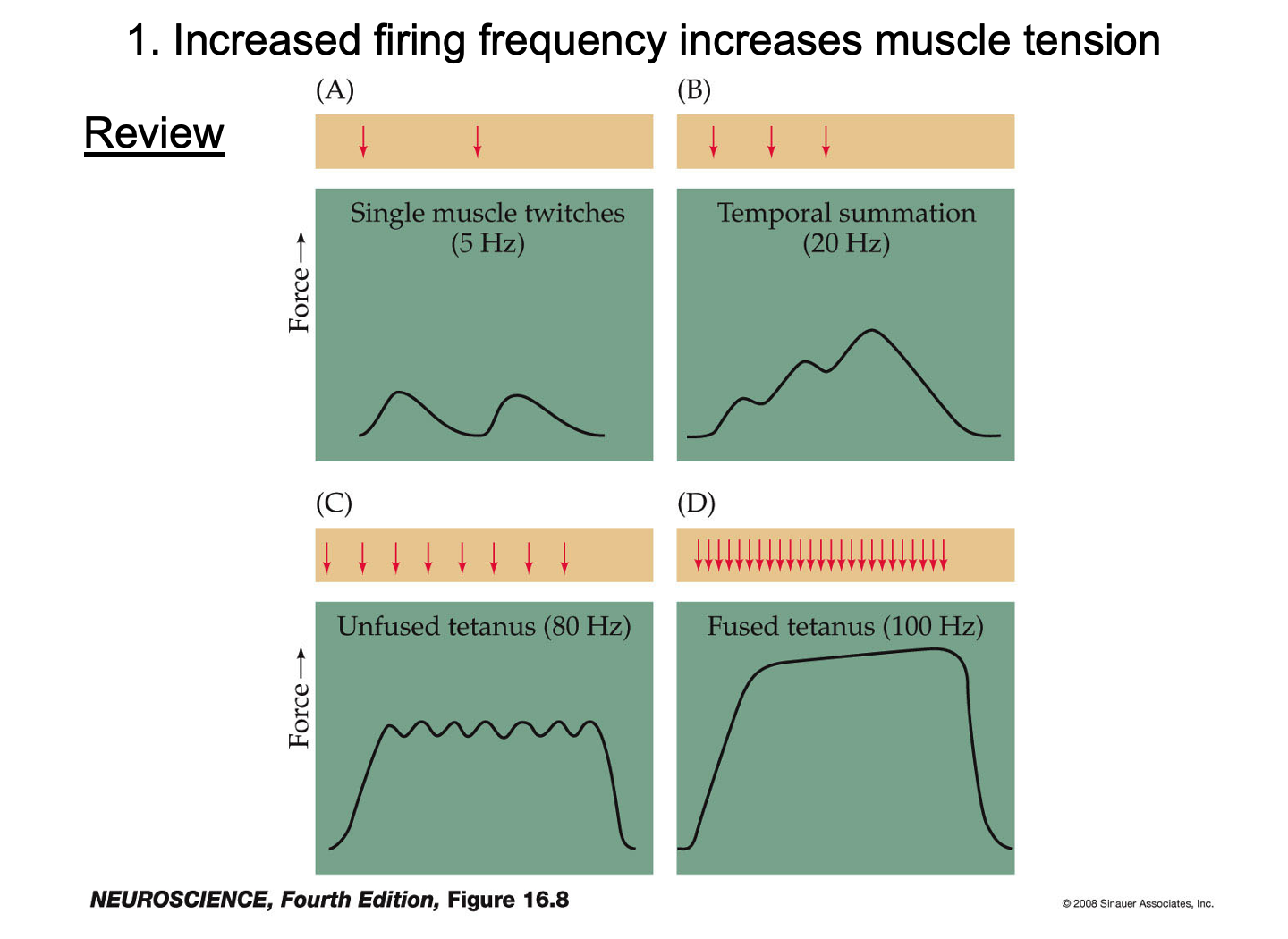
What happens when a motor neuron fires at low frequency (5 Hz)?
It produces isolated muscle twitches, each with full relaxation
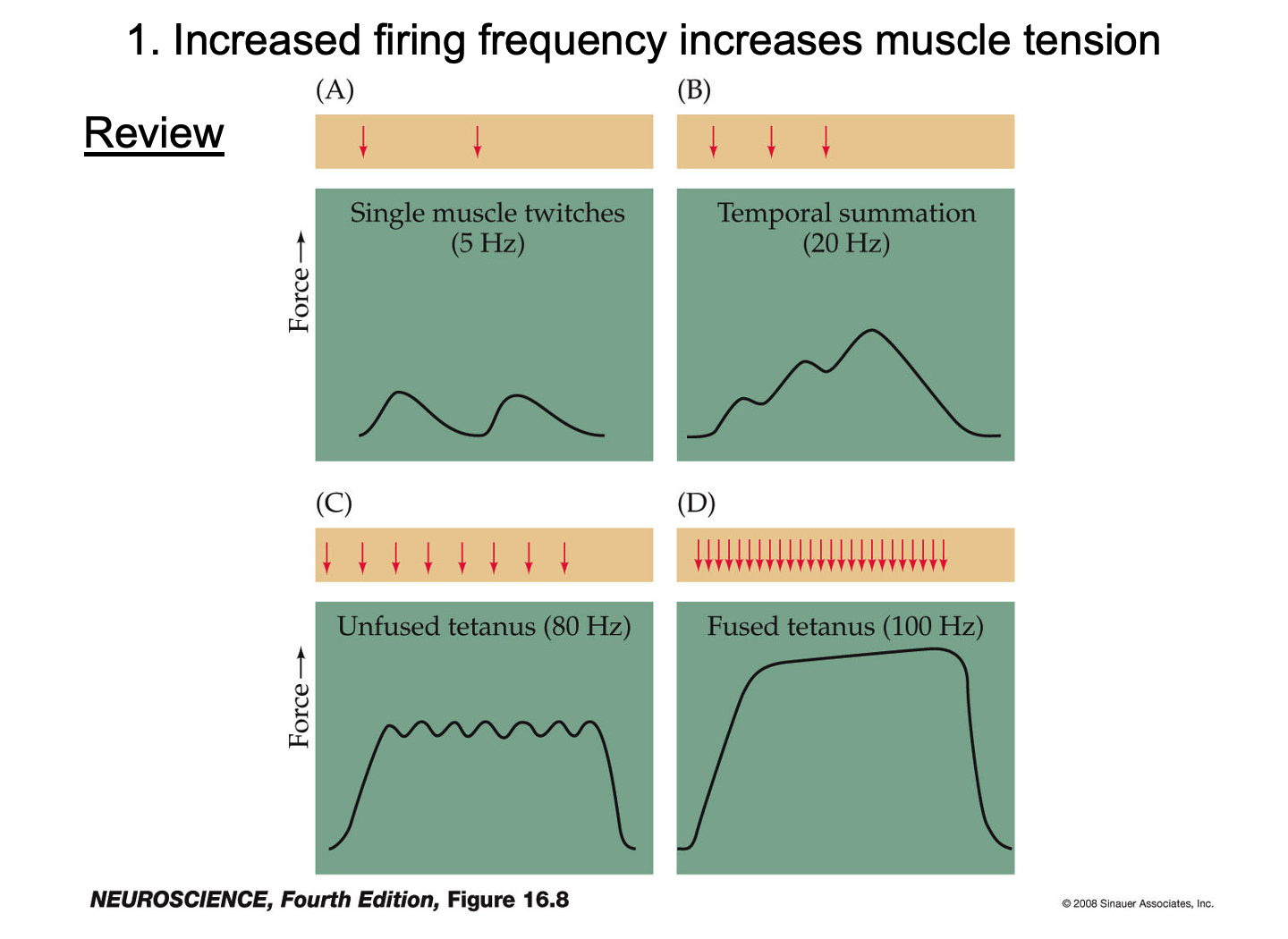
What is temporal summation in muscle contraction?
When increased firing frequency leads to twitches that build on each other, raising overall force
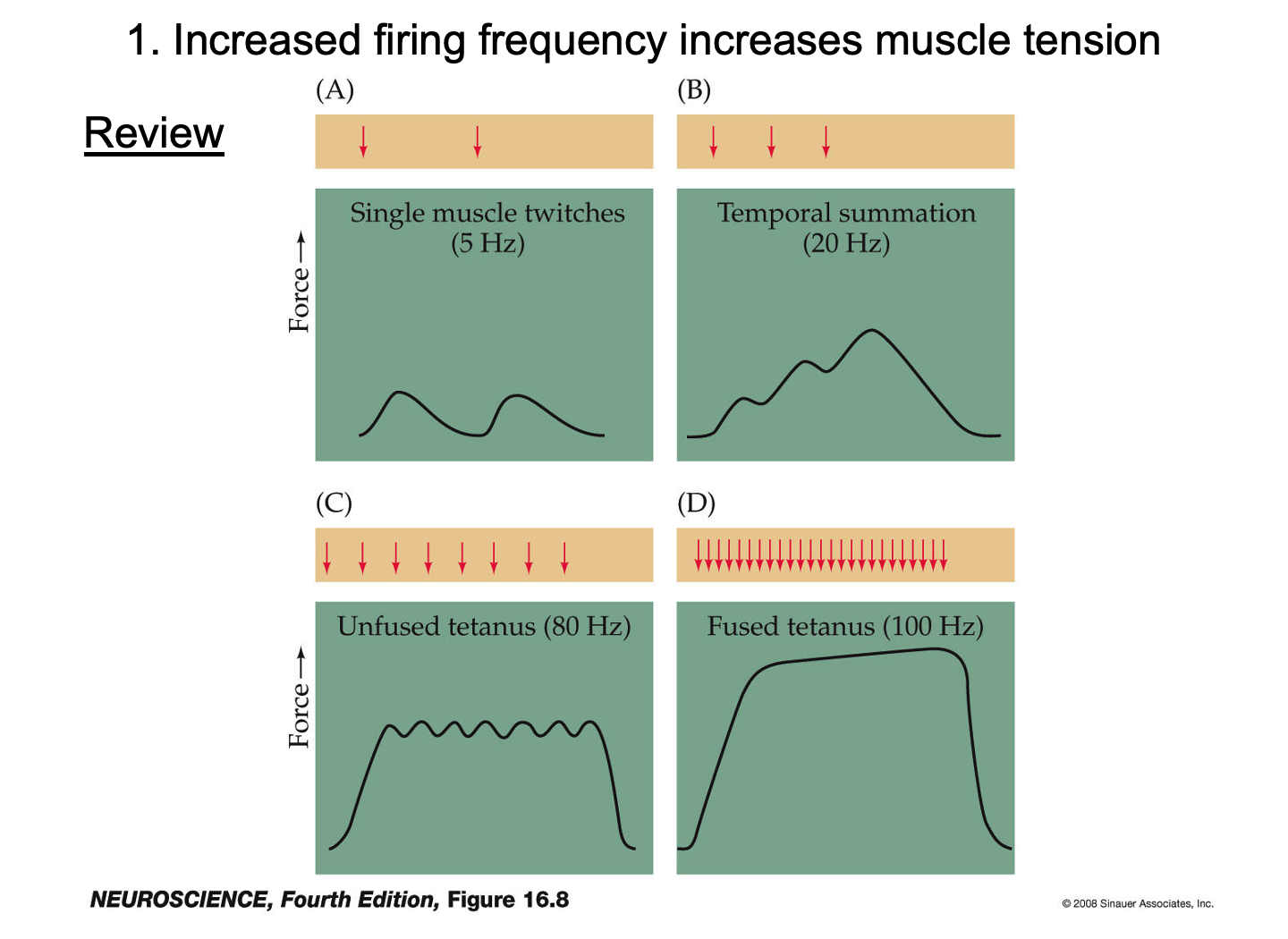
At 80 Hz, twitches begin to blend, producing an unfused tetanus with some __________ between contractions.
fluctuation
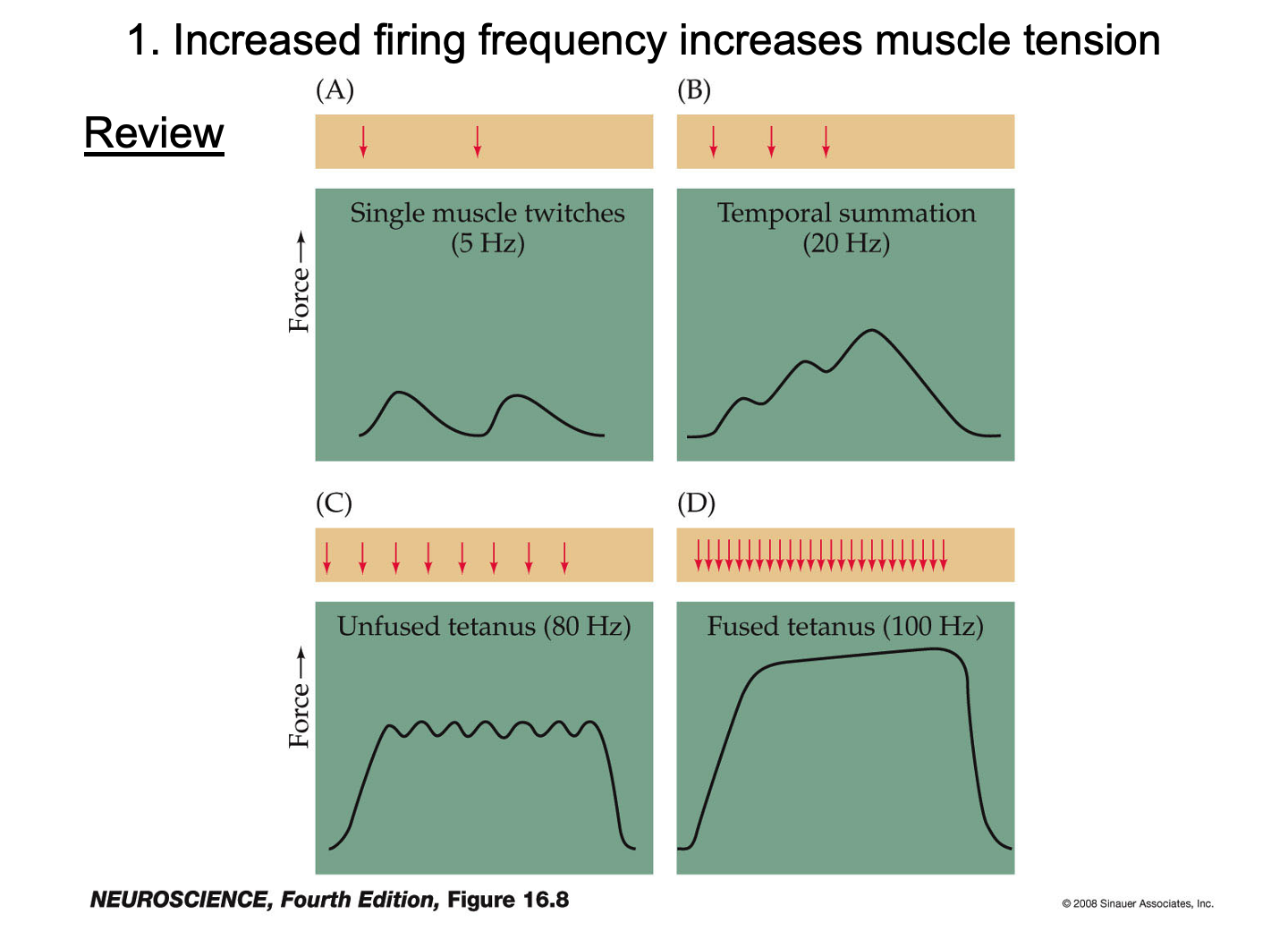
What is a fused tetanus, and when does it occur?
A smooth, sustained contraction that occurs at very high stimulation frequency (e.g., 100 Hz)
What physiological mechanism allows muscles to produce graded increases in tension even from a single motor unit?
By increasing the firing rate of that motor neuron
Recruitment of additional motor units increases muscle tension:
Each neuron of a pool innervates a separate set of myofibers.
Thus, activating more motor units results in greater force production capacity.
Why is the scattered distribution of motor unit fibers important?
It allows even force production and prevents localized damage from neuron loss
What determines how many motor units are recruited for a task?
The load or force requirement — more units for heavier tasks
Writing with a pen recruits fewer motor units than __________.
lifting a table
What happens as force demand increases during a movement?
Progressively larger motor units are recruited (following the Size Principle)
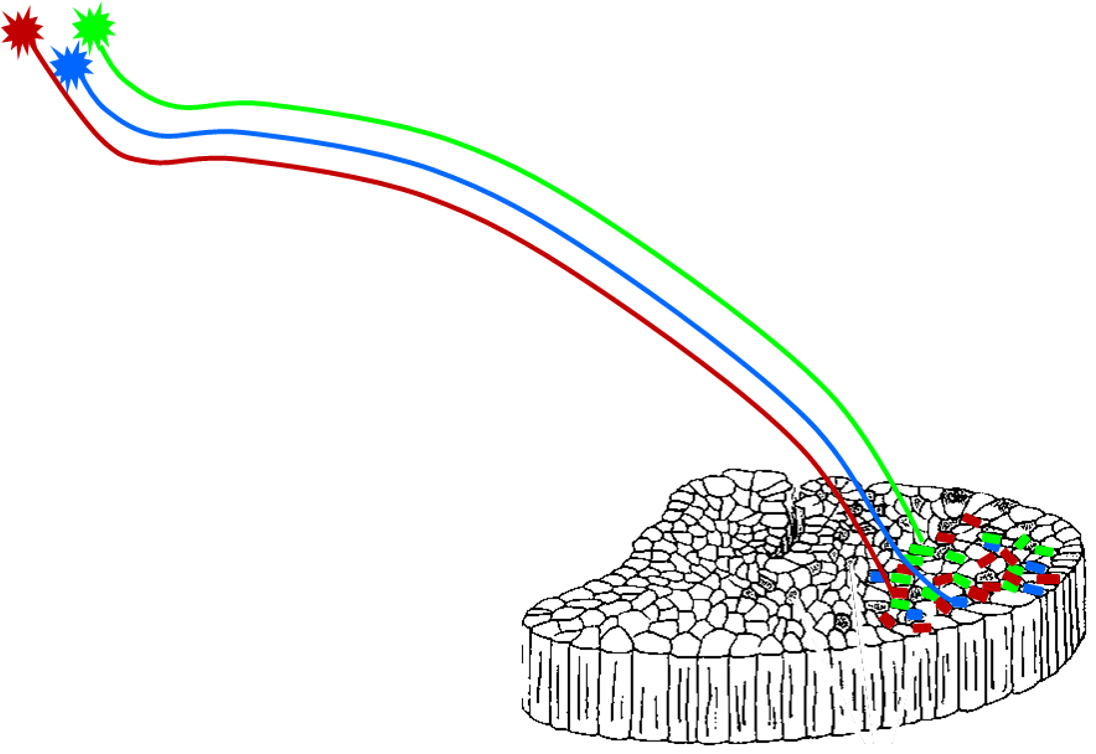
What does this diagram show about motor neurons and their target fibers?
Each motor neuron innervates many myofibers spread across the muscle, contributing to overlapping motor unit territories
In what order are motor units recruited during increasing force demands?
First Type I (slow) → then Type IIA (fast fatigue-resistant) → finally Type IIB (fast fatiguable)
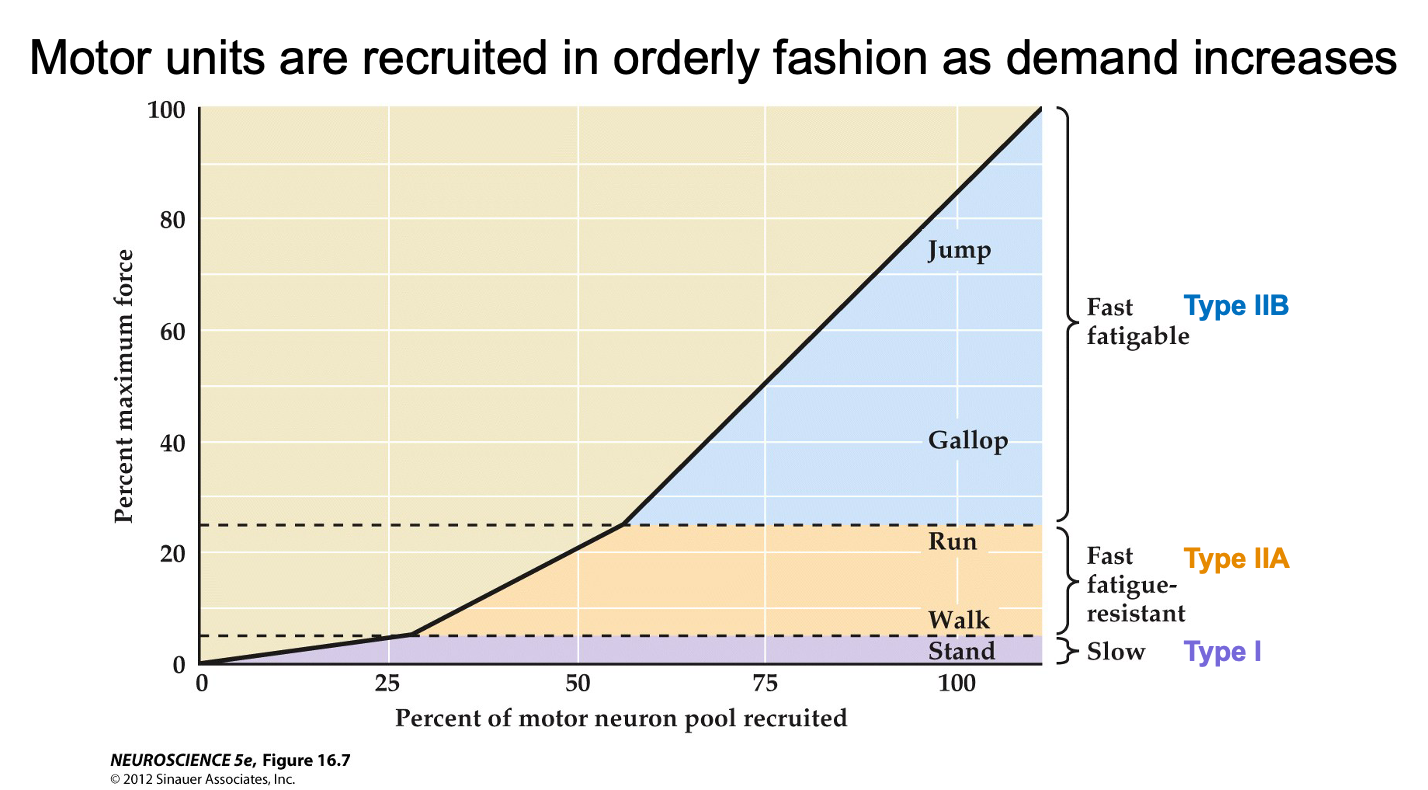
Graph shows recruitment of motor units in the medial gastrocnemius muscles of a cat during different voluntary behaviors:
______ motor units provide the force required for standing.
Slow
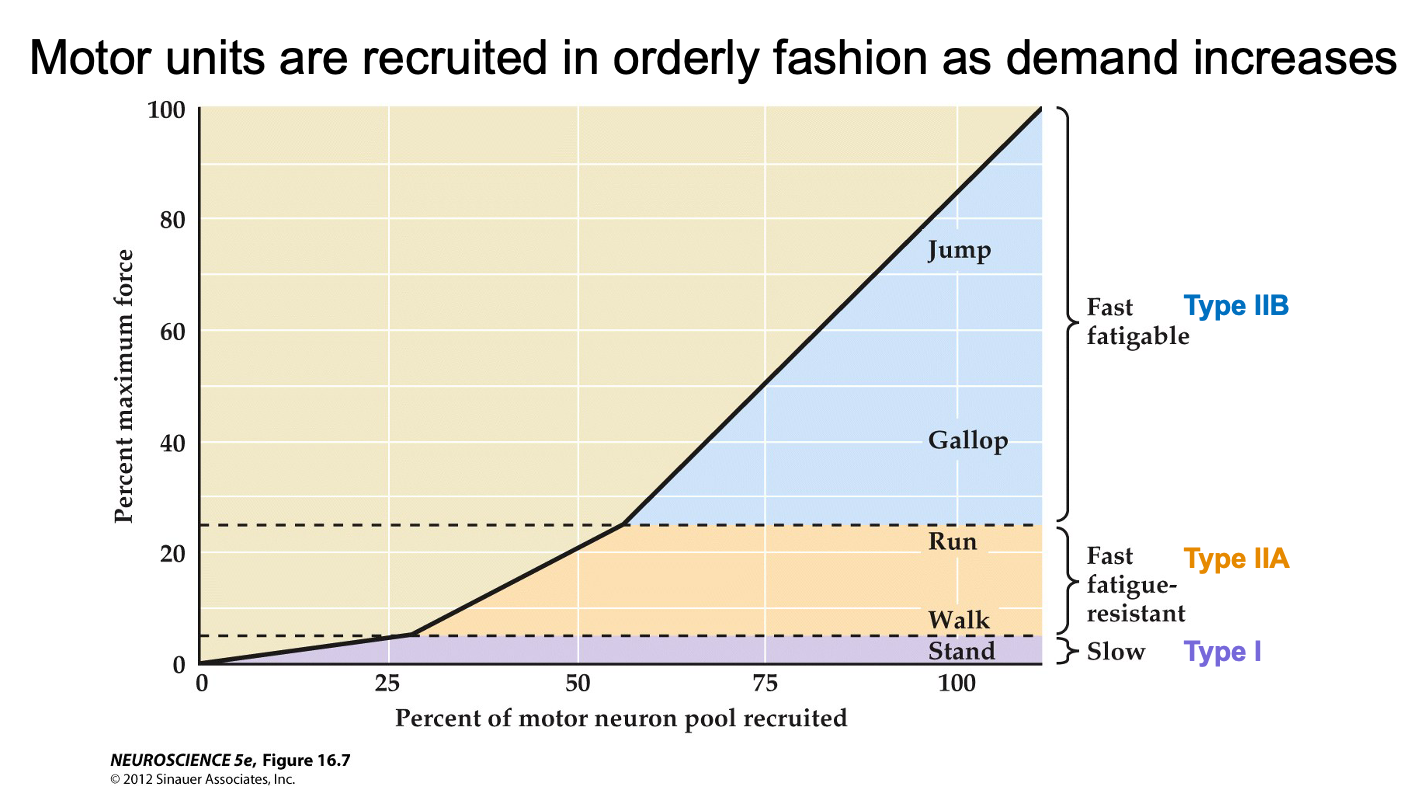
Graph shows recruitment of motor units in the medial gastrocnemius muscles of a cat during different voluntary behaviors:
____________ fibers provide more force for walking and running
Fast Fatigue-resistant
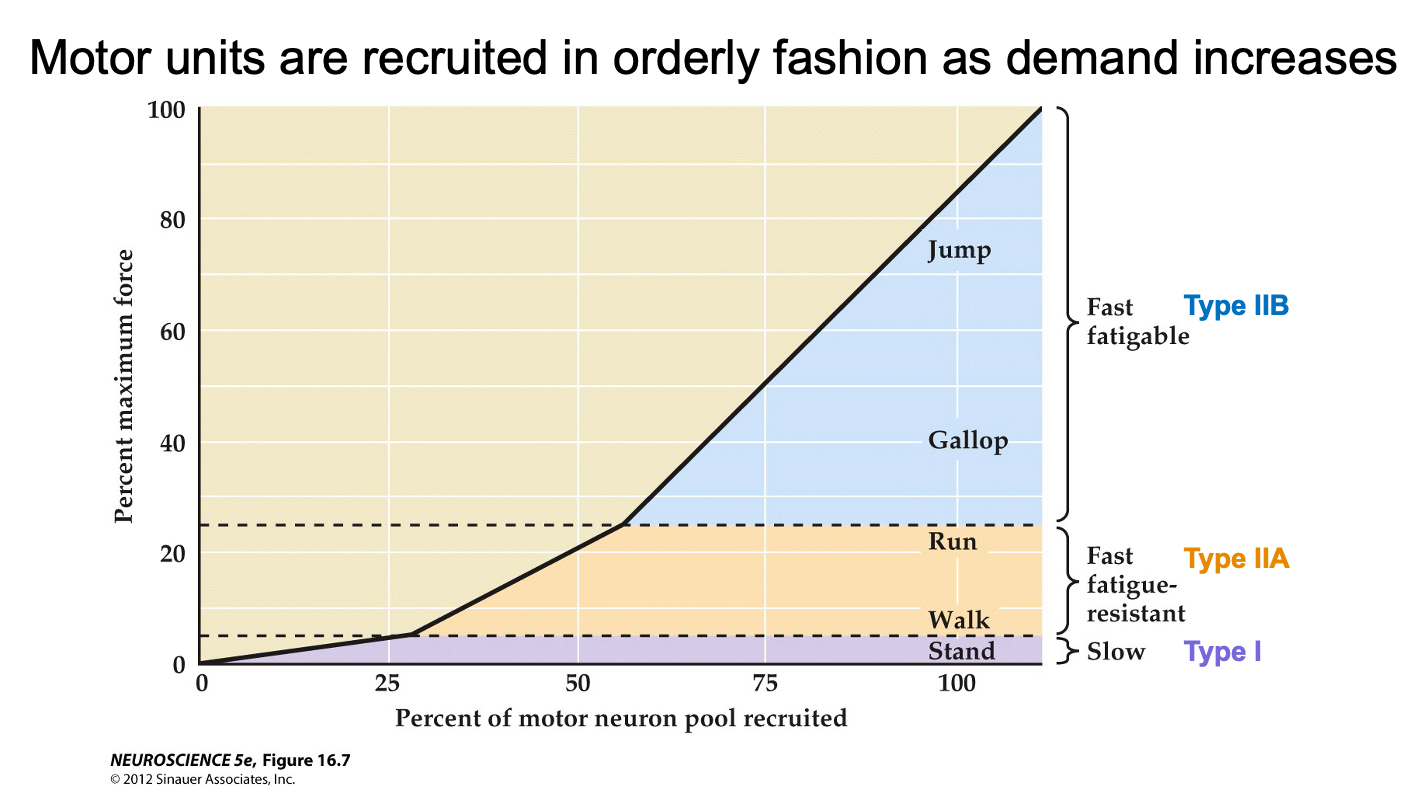
Graph shows recruitment of motor units in the medial gastrocnemius muscles of a cat during different voluntary behaviors:
________ units are recruited only for the most strenuous activities.
Fast Fatigable
Motor units are recruited according to the __________
Size Principle
Small motor units (=small α-motor neurons, few muscle fibers) are recruited first:
Generate limited force but with higher precision
Used for fine motor functions - writing, surgery
Progressively larger motor units (=large α-motor neurons, many fibers) are recruited later:
Generate greater force
Used for gross motor functions
Motor units ________ in reverse order: largest first, smallest last.
terminate activity
The largest units (especially fast-fatiguable fibers), work for the ______ duration.
shortest
Increased force typically is produced simultaneously by both:
Increased firing rate of motor units
Recruiting additional motor units
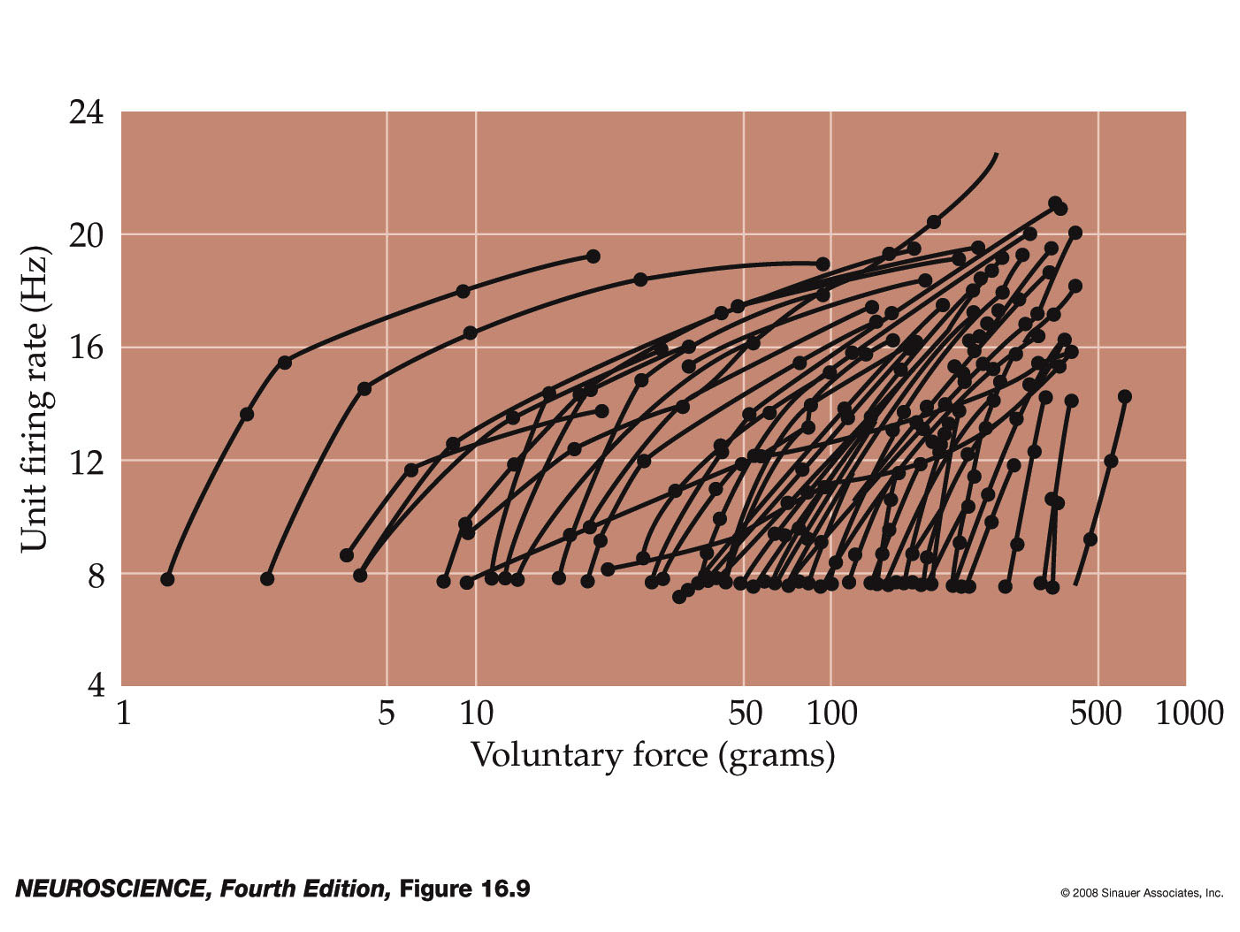
What does each trace on the graph represent?
A different motor unit in the muscles of the human hand
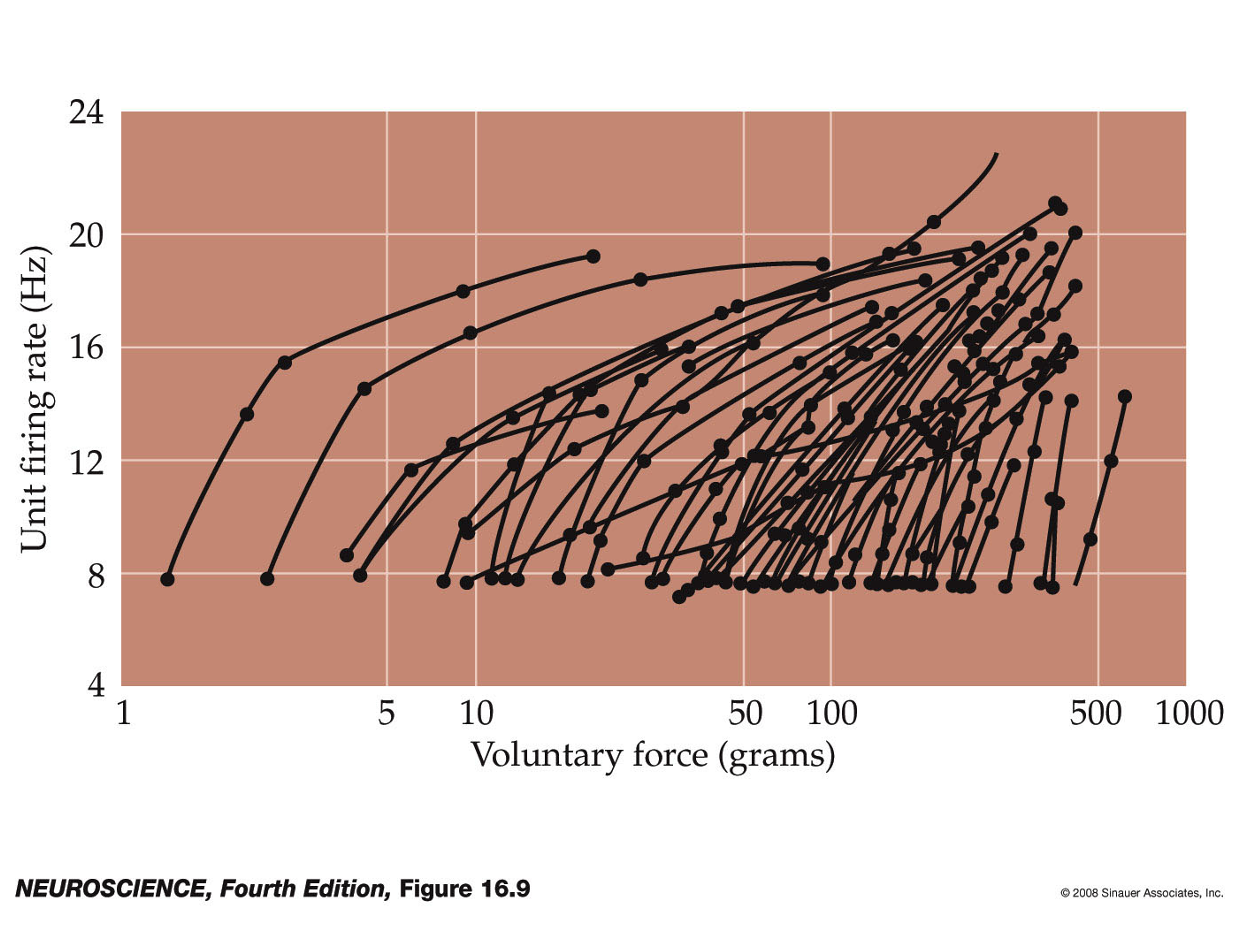
What clinical tool or method can generate this kind of motor unit firing pattern?
EMG recording during a voluntary grip/squeeze — often done in neurology clinics
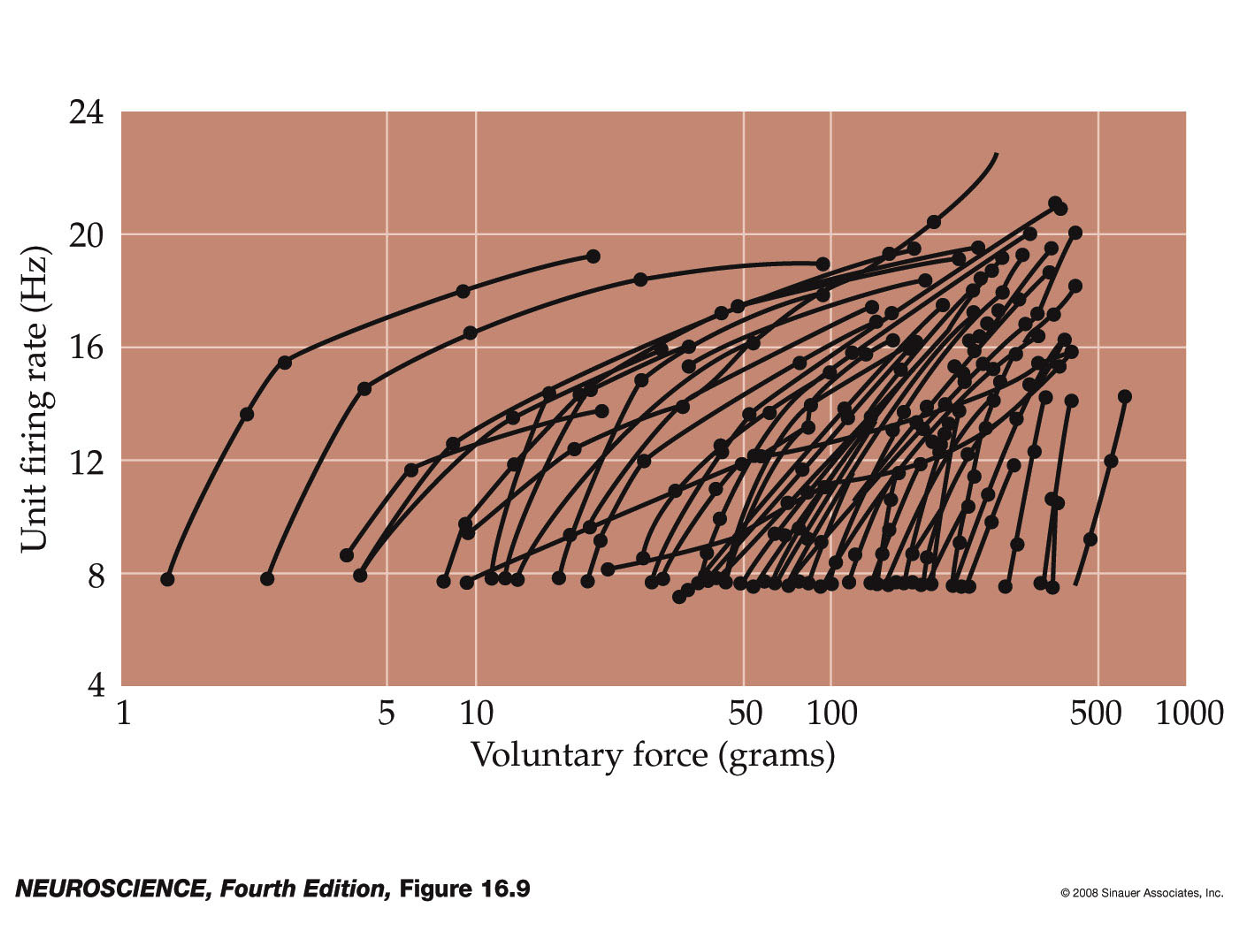
Why is the hand a useful muscle for studying motor unit recruitment?
It has many small, precise motor units that can be independently recorded

___________: properties of motor units can be changed by stimulation frequency
Motor Unit Plasticity
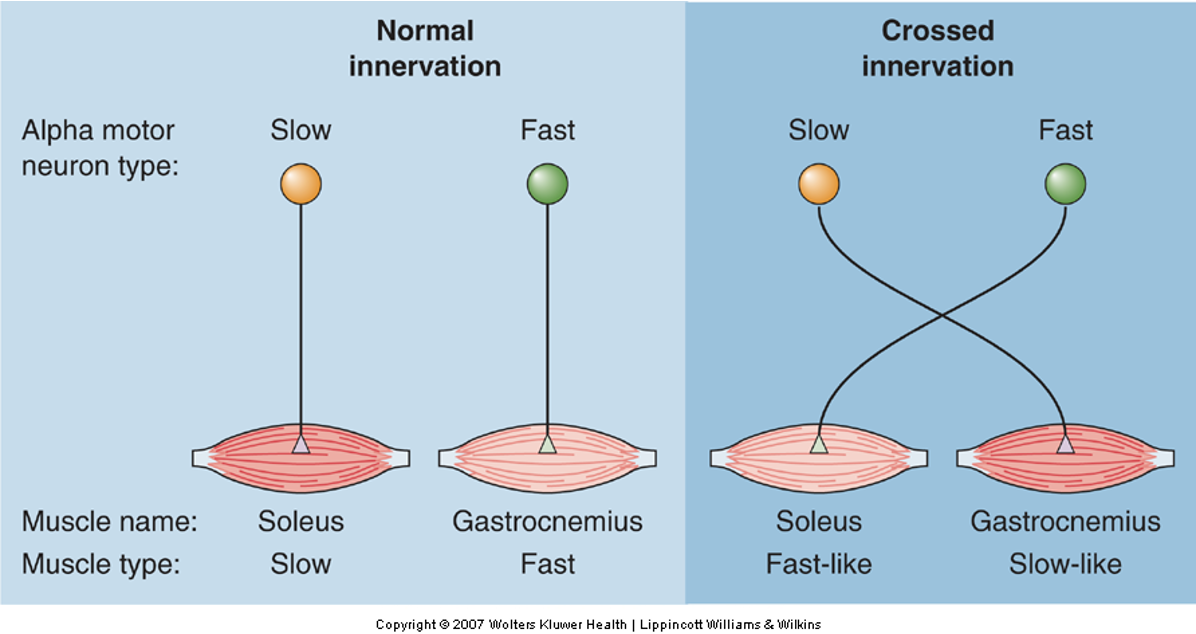
What was the key finding of the cross-innervation experiment?
Motor neurons control muscle fiber type (type determines type)
When a slow motor neuron innervates a fast muscle (e.g., gastrocnemius), it becomes more __________-like.
slow
What happens when a fast motor neuron innervates a slow muscle (e.g., soleus)?
The muscle takes on fast-like properties
What do we call the ability of muscles to shift phenotype based on the input they receive?
Motor unit plasticity
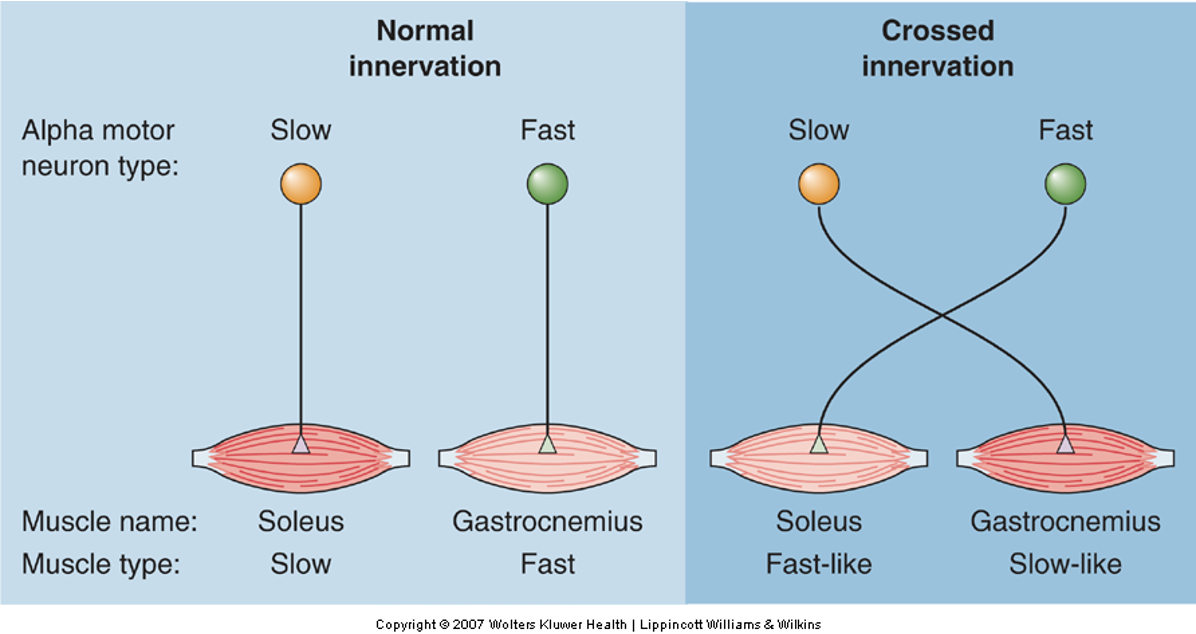
What was the general method used in this experiment?
Motor nerves were cut and rerouted to the opposite muscle’s distal end
What happens to fast motor units when they are chronically stimulated at low frequency?
They begin to adopt slow motor unit characteristics (e.g., longer time to peak, slower relaxation)
What physiological marker is used to assess whether a fiber is fast or slow?
Time to peak contraction and after-hyperpolarization decay time
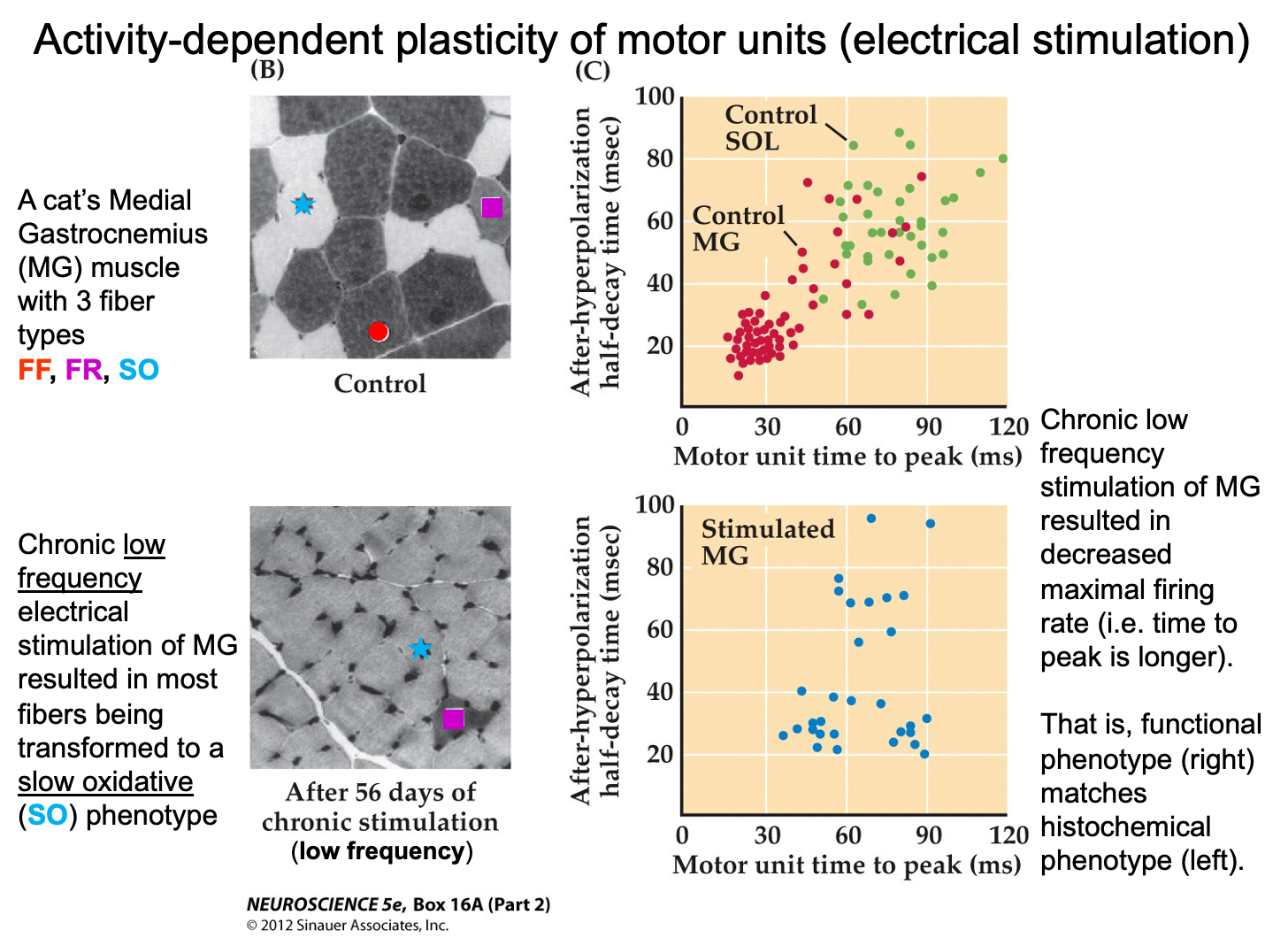
How can this concept apply to everyday life?
Through exercise training — endurance training can shift fiber type from fast glycolytic to more oxidative
_______________ allows muscle fiber type to shift
Activity-dependent plasticity